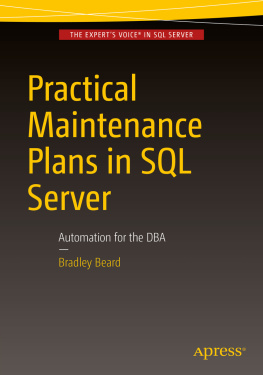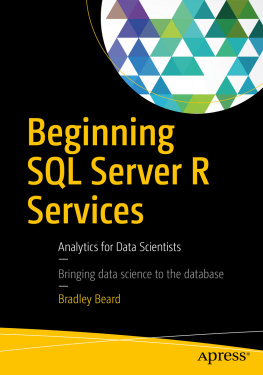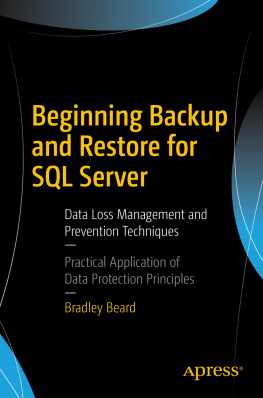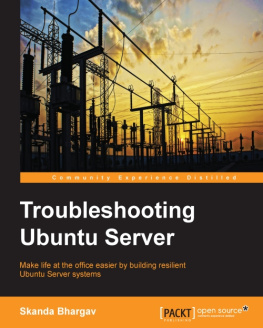Bradley Beard - Practical Maintenance Plans in SQL Server
Here you can read online Bradley Beard - Practical Maintenance Plans in SQL Server full text of the book (entire story) in english for free. Download pdf and epub, get meaning, cover and reviews about this ebook. City: Berkeley;CA, publisher: Apress, genre: Computer. Description of the work, (preface) as well as reviews are available. Best literature library LitArk.com created for fans of good reading and offers a wide selection of genres:
Romance novel
Science fiction
Adventure
Detective
Science
History
Home and family
Prose
Art
Politics
Computer
Non-fiction
Religion
Business
Children
Humor
Choose a favorite category and find really read worthwhile books. Enjoy immersion in the world of imagination, feel the emotions of the characters or learn something new for yourself, make an fascinating discovery.
- Book:Practical Maintenance Plans in SQL Server
- Author:
- Publisher:Apress
- Genre:
- City:Berkeley;CA
- Rating:3 / 5
- Favourites:Add to favourites
- Your mark:
- 60
- 1
- 2
- 3
- 4
- 5
Practical Maintenance Plans in SQL Server: summary, description and annotation
We offer to read an annotation, description, summary or preface (depends on what the author of the book "Practical Maintenance Plans in SQL Server" wrote himself). If you haven't found the necessary information about the book — write in the comments, we will try to find it.
Bradley Beard: author's other books
Who wrote Practical Maintenance Plans in SQL Server? Find out the surname, the name of the author of the book and a list of all author's works by series.
Practical Maintenance Plans in SQL Server — read online for free the complete book (whole text) full work
Below is the text of the book, divided by pages. System saving the place of the last page read, allows you to conveniently read the book "Practical Maintenance Plans in SQL Server" online for free, without having to search again every time where you left off. Put a bookmark, and you can go to the page where you finished reading at any time.
Font size:
Interval:
Bookmark:
- Backups : The .bak files for each backup, stored in folders per database
- Data : The .mdf and .ldf files for each database, stored in folders per database
- Logs : The .trn files for each database, stored in folders per database
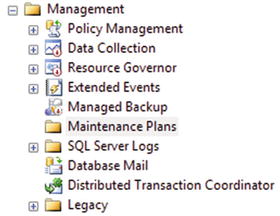
- Check Database Integrity : The Check Database Integrity task performs internal consistency checks of the data and index pages within the database.
- Shrink Database : The Shrink Database task reduces the disk space consumed by the database and log files by removing empty data and log pages.
- Reorganize Index : The Reorganize Index task defragments and compacts clustered and nonclustered indexes on tables and views. This improves index-scanning performance.
- Rebuild Index : The Rebuild Index task reorganizes data on the data and index pages by rebuilding indexes. This improves performance of index scans and seeks. This task also optimizes the distribution of data and free space on the index pages, allowing faster future growth.
- Update Statistics : The Update Statistics task ensures the query optimizer has up-to-date information about the distribution of data values in the tables. This allows the optimizer to make better judgments about data access strategies.
- Clean Up History : The History Cleanup task deletes historical data about Backup and Restore, SQL Server Agent, and Maintenance Plan operations. This wizard allows you to specify the type and age of the data to be deleted.
- Execute SQL Server Agent Job : The Execute SQL Server Agent Job task allows you to select SQL Server Agent jobs to run as part of the maintenance plan.
Font size:
Interval:
Bookmark:
Similar books «Practical Maintenance Plans in SQL Server»
Look at similar books to Practical Maintenance Plans in SQL Server. We have selected literature similar in name and meaning in the hope of providing readers with more options to find new, interesting, not yet read works.
Discussion, reviews of the book Practical Maintenance Plans in SQL Server and just readers' own opinions. Leave your comments, write what you think about the work, its meaning or the main characters. Specify what exactly you liked and what you didn't like, and why you think so.

